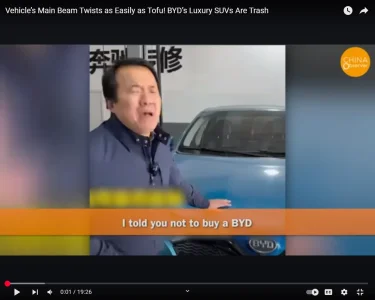- Joined
- Jul 3, 2024
- Messages
- 771
- Likes
- 367

Egypt, China, and talks on an advanced radar system and TOT
Discover the talks between Egypt and China for the procurement of an advanced radar system and TOT agreement.

idk anon those bond yields definitely collapsedIndiabros, you were right,
The Chinese economy often collapses several times a month at the DFB

Donald Trump’s tariff plans turn Chinese investment in Mexico into a waiting game

Trump’s tariff plans turn Chinese investment in Mexico into a waiting game
US president-elect on Monday said his new administration would immediately impose a 25 per cent tariff on imports from Mexico.www.scmp.com
China’s BYD pauses Mexico factory plans until after US election

China’s BYD pauses Mexico factory plans until after US election
Mexico could be a key production site for BYD, along with plants it is building or already operating in Brazil, Hungary, Turkey and Thailand.www.scmp.com









 vanguardia.com.mx
vanguardia.com.mx
View attachment 18888
View attachment 18889
View attachment 18890
View attachment 18891
View attachment 18892
Sheinbaum, on the BYD plant in Mexico: “There is no Chinese automotive investment project”
The Mexican president assured that she will give priority to investments from countries with which she has a trade agreement, such as the United States
The president has emphasized that Mexico is not closed to the arrival of Chinese investment in the country, but indicated that priority will be given to trade with countries with which it has a trade agreement, such as the United States and Canada. “We have to see which project and under what circumstances,” said Sheinbaum regarding Chinese investment. Sheinbaum's refusal on the subject, a few hours after her call with President-elect Donald Trump, once again puts the plans of the electric car giant BYD in uncertain territory.
The company has not yet commented on Sheinbaum's statements, however, in its latest launch in Mexico City, just before the US presidential elections, the company's executives confirmed their plans to build an electric vehicle plant to supply the domestic market, and even Latin America. At that time, Ray Zou, president of BYD Mexico, detailed that the plant would generate between 5,000 and 10,000 jobs and would be ready in one or two years. He also insisted that this manufacturing center does not plan to supply the US market, as Republican Trump has suggested in the past.
The interest of Chinese companies in Mexico has been on the rise in the last decade. During the first half of this year, foreign direct investment from this country on American soil exceeded 235 million dollars, a figure higher than the 11 million dollars in investment registered in all of 2010, according to figures from the Ministry of Economy. The arrival of Chinese electric cars imported into the country has fostered demand for Chinese auto parts, semiconductors and components.
The recent threat by the US president-elect to raise tariffs on imports from Mexico is in line with other statements he made during his campaign about an alleged triangulation of Asian trade, via its southern neighbor. The Mexican government has insistently denied this crossing of goods and has responded to threats of a higher tariff barrier with the same currency, assuring that “one tariff will come next.”
The bilateral tension has raised alarm bells about the economic future of the Latin American country. The market was quick to react and the exchange rate of the peso against the dollar weakened, once again, to levels above 20.80 units per dollar this week, while the rating agencies and financial centers adjusted, downwards, the expectations of economic growth in Mexico. This episode has been settled, for the moment, with a call between Sheinbaum and Trump in which they talked about the control of the northern border in matters of migration and drug trafficking. The issue of tariffs was not on the table, for now.

Sheinbaum, sobre la planta de BYD en México: “No existe ningún proyecto de inversión automotriz chino”
La presidenta mexicana aseguró que dará prioridad a las inversiones de países con los que tiene un tratado comercial como Estados Unidoselpais.com
View attachment 18893
Chinese vehicle brands were the “worst” rated among Mexican consumers and with the highest number of problems reported in the operation of the unit. Among the most common failures are: the infotainment system, the powertrain and driving assistance, revealed a study by JD Power as of August 2024. According to the Automotive Design and Performance 2024 (APEAL) study, section of the Vehicle Quality and Reliability Study (VDS) conducted by JD Power Mexico 2024, Chinese and French car brands are the ones that report the highest number of problems for consumers, with 271 and 254 failures per 100 units, respectively, compared to 176 for Italians and 201 for Japan.
Based on a survey of 7,169 consumers of 26 brands and 134 models between 1 and 3 years old, conducted from November 2023 to August 2024, the company ranked the Chinese brand MG as the worst rated with 807 points in design and performance satisfaction. In contrast, Toyota is ranked highest rated with 907 points.

Marcas de vehículos chinos, las peor evaluadas en México
Una encuesta de consumo arrojó que la marca china MG es la de menor puntaje en satisfacción de diseño y desempeño; en contraste, Toyota es la mejorwww.eleconomista.com.mx
Consumer complaints against Chinese-made cars are increasing in Mexico
At the moment, the largest number of reports to Profeco is against Chirey and MG; they highlight breach of warranty and deficiencies in repair and refusal to terminate the contract
Chinese automakers are already beginning to face complaints from their clients before the Federal Consumer Protection Agency (Profeco) as part of their entry and growth in the Mexican market.
From 2021 and so far this year, Chirey and MG have a combined total of 181 complaints, according to the Profeco Commercial Bureau.
Of that total, Chirey is responsible for 98 complaints between 2022 and 2024; SAIC, the marketer of the MG brand, is involved in 83 complaints between 2021 and 2024.
Profeco indicates that the main reasons for complaints at the national level are the refusal to enforce the guarantee, manufacturing defects, deficiencies in repair, refusal to terminate the contract and refusal to deliver the product or service.

Aceleran en México quejas de consumidores en contra de los autos de fabricación china
$TextoEscvanguardia.com.mx

GMC Ranks Below Average In J.D. Power 2022 Mexico Vehicle Dependability Study
View attachment 18895


 www.elcarrocolombiano.com
www.elcarrocolombiano.com

 vanguardia.com.mx
vanguardia.com.mx

3/1417=0.002
- The current population of China is 1,417,817,433 as of Wednesday, December 18, 2024, based on Worldometer's elaboration of the latest United Nations data1.
In few words 2 of 1000 people buy EVs in China

China Population (2025) - Worldometer
Population of China: current, historical, and projected population, growth rate, immigration, median age, total fertility rate (TFR), population density, urbanization, urban population, country's share of world population, and global rank. Data tables, maps, charts, and live population clockwww.worldometers.info

But in January 2015, when a commercial-grade drone loaded with drugs fell out of the night sky in Tijuana, the narcodrone picture took on a new focus. The DJI Spreading Wings S-900 hexacopter, designed for professional photography and filmmaking, crashed in a Tijuana grocery store parking lot, just across the border from the California town of San Ysidro. Mexican police recovered more than six pounds of methamphetamine with a street value approaching $43,000. Four months later, Valle and Elias were caught.
In 2017, CBP heard a drone fly overhead as it crossed the border fence near San Ysidro and tracked it to a residential neighborhood. Agents captured 25-year-old Jorge Edwin Rivera with 13 pounds of methamphetamine. Rivera’s drone, found hidden under a bush, was a $5,000 DJI Matrice 600; the Matrice is DJI’s largest drone, and the package Rivera collected carried its maximum payload. He told investigators that prior to his arrest he had been involved in five or six other deliveries over the previous six months. Rivera received a 12-year prison sentence.



Mexico with very low comsuption power on industrial products, due to the USA almost destroyed Mexico agricutlre and industrial bases, only assembly factories left and took out all lthe profitble sectors, made even profitble avocado controlled by cartels.
In 2023, approximately 1.4 million light passenger vehicles were sold in the Mexico, out of which around 598,100 cars and 763,300 light trucks.
With 30.09 million units sold in 2023, China maintained its position as the world's largest automobile seller. That number included overseas shipments, which grew 58% to 4.91 million units.
China population is 11 times than Mexico, and vehicle sales are 21 times than Mexico.
View attachment 18910
And from July, Electric vehicles and plug-in hybrids likely surpassed 50 per cent of all vehicles sales in China for the first time in July, even as the overall number of cars sold fell, marking a key milestone in the country's auto market.







DJI is the most popular drone used in Meixco, but the market share is quite hard to be determined.
How Many Drones Are Smuggling Drugs Across the U.S. Southern Border?

How Many Drones Are Smuggling Drugs Across the U.S. Southern Border?
Answer: Nobody knows.www.smithsonianmag.com
Inside Mexico's Cartel Drone War

Inside Mexico's Cartel Drone War
I went to the state of Guerrero where gangsters rain makeshift bombswww.crashoutmedia.com


View attachment 18915
View attachment 18916
obviously 5 year old children own a car
View attachment 18917
Cars by Country 2024
Mexico 370 49M 2023
China 231 329.1M 2023
Cars by Country 2025
Discover population, economy, health, and more with the most comprehensive global statistics at your fingertips.worldpopulationreview.com
Math problem
231/1417 =? 49/130=?
View: https://www.youtube.com/watch?v=HPLoze_rGjQ
View attachment 18921
View attachment 18922
Interview with Alejandro Franco, CEO of QSM Semiconductores, a Mexican company dedicated to the development of innovative solutions based on semiconductor technologies to meet global market demand, through design, engineering and manufacturing.
View attachment 18923
View attachment 18924


 cnevpost.com
cnevpost.com

Chinese EV companies supported university EV games and teams for 10 yrs.
View attachment 18926

Nio launches support for Formula Student Germany
Nio will enter the German market this year, and the latest move appears to signal that the company is stepping up its efforts to build its brand image there.cnevpost.com
View: https://www.instagram.com/changanuniversity/p/DCX90yrPMDV/?img_index=1
View: https://www.facebook.com/NIOGlobal/posts/the-2024-nio-cup-formula-student-electric-china-fsec-is-heating-up-teams-from-un/595296446186816/
So far, there is only one Mexican university even in top100
View attachment 18925

why you are so childish?
Universities do not mean a thing at all it is job experience and intelligence what matters
To prove
View attachment 18931
These online discussions reflect the prevailing phenomenon in the urban area, including the major cities like Beijing, Shanghai, and Guangzhou. By June 2023, China’s youth unemployment rate had reached a historical high point of 21.3%, nearly double the pre-pandemic rate in 2019.
So what university degree and unemployed
Wel, young students of China hard to find job.
and young students of Mexico hard to find.
Case of Mexico’s 43 missing students persists among tens of thousands of disappearances

Case of Mexico's 43 missing students persists among tens of thousands of disappearances
All countries have crimes that resonate. Mexico's is the disappearance of 43 students from a rural teacher’s college in 2014.apnews.com








